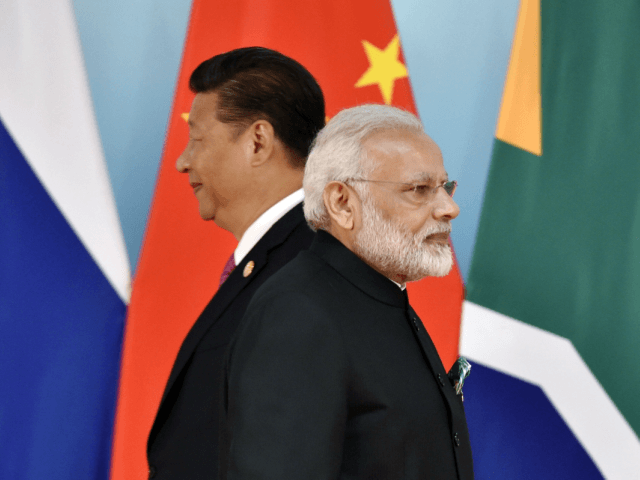Indian media reported on Monday that China’s People’s Liberation Army (PLA) had finally started retreating at the Indian border, weeks after a bloody clash in which Chinese troops attacked their Indian counterparts with, among other weapons, sticks wrapped in barbed wire.
The Chinese Foreign Ministry insisted on Monday that Beijing had made an agreement to de-escalate border tensions with New Delhi that required India to withdraw, as well. The June brawl in the Galwan Valley, in the Ladakh region of India began when Indian soldiers found PLA troops establishing themselves on Indian territory, so Indian soldiers presumably did not have anywhere to retreat from.
The reports this week are significantly different from satellite image indications in the weeks following the incident in Ladakh that China had begun building new facilities and erecting tents on Indian land.
The Galwan Valley brawl left over 20 Indian soldiers dead, including some hurled off the steep Himalayan cliffs of the area and others killed by the frigid temperatures. Indian officials have said they believe China suffered double the number of casualties as the Indians, but Beijing refuses to acknowledge or name any injured or killed soldiers. Relatives of soldiers stationed near the Indian border and other civilians have begun expressing unease online about China’s refusal to honor the dead and maimed, though China’s Communist Party censors rapidly delete most disagreements with the regime.
Unnamed sources – the outlet leaves unclear if Indian or Chinese – told India’s NDTV that the Chinese military had withdrawn from three separate areas in Ladakh, including the Galwan Valley.
“Indian soldiers have also pulled back and a buffer zone has been created between the troops of both sides, according to the sources,” NDTV noted.
While NDTV said the Chinese had withdrawn by “at least one kilometer,” The Hindu estimated that China had retreated two kilometers at the Galwan Valley part of the border, citing Indian government officials.
“Chinese troops have shifted two km from the face-off site in Galwan. Temporary structures being removed by both sides,” an unnamed Indian government source said.
The Times of India reported similarly, describing the drawback on the border as requiring “2.5 to 3 km” of movement back by both militaries at a time, “which will later be followed by de-induction of huge military build-ups along the LAC [Line of Actual Control, the China-India border].”
The Indian outlets agreed that it appeared that the offending PLA tents on Indian territory had been uprooted and that there were no more reports of Chinese soldiers present on Indian territory.
The disengagement appeared to follow an extensive meeting between Chinese Foreign Minister Wang Yi and Indian National Security Advisor Ajit Doval over the weekend. India’s Ministry of External Affairs (MEA) described the meeting as “frank and in-depth,” and expressed hope that it would soon lead to a permanent end to violence on the border. The meeting reportedly lasted for two hours.
“NSA Ajit Doval and Chinese FM Wang Yi will continue their conversations to ensure full and enduring restoration of peace and tranquillity in the India-China border areas in accordance with the bilateral agreements and protocols,” the MEA asserted. “They reaffirmed that both sides should strictly respect and observe the Line of Actual Control and should not take any unilateral action to alter the status quo and work together to avoid any incident in the future that could disturb peace and tranquillity in border areas.”
China’s Foreign Ministry appeared to confirm the Indian version of events in its daily press briefing Monday.
“Both sides agreed to continue implementing previous consensus reached at the last two rounds of commander-level talks and made progress in taking effective measures on disengagement and easing tensions in the border areas by frontline troops,” Foreign Ministry spokesman Zhao Lijian said. “We hope India will meet China halfway, implement our consensus by taking concrete actions, keep in close contact with China via military and diplomatic channels, and work with China to deescalate tensions in the border areas.”
Zhao Lijian remains a Foreign Ministry figurehead despite being responsible for the unsubstantiated conspiracy theory that the Chinese coronavirus originated in Maryland.
China’s withdrawal followed a visit to the border by Prime Minister Narendra Modi in which he inspected the Ladakh area and met with survivors of the Galwan Valley attack. Modi gave an impassioned speech celebrating the Indian military as “mightier and better than anyone else in the world.”
“The era of expansionism has come to an end,” Modi declared in his remarks, appearing to address the Chinese Communist Party. “This is the era of development… History has proved that expansionist forces have either lost or were forced to turn back.”
While a significant defeat for China – Beijing began suddenly claiming that the Galwan Valley was Chinese territory, a move without significant precedent, following the June brawl – the state-run Global Times propaganda outlet heralded the talks as “progress.” It’s typical Beijing-approved expert commentary celebrated the “positive” tone of the discussion.

COMMENTS
Please let us know if you're having issues with commenting.